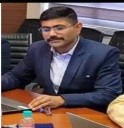
Dr. Kunjee Lal Meena has done Doctorate from Indian Institute of Technology (IIT) Roorkee, India. He graduated in Mechanical Engineering from Maulana Azad National Indian Institute of Technology (MANIT) Bhopal. His areas of interest are production technology, manufacturing system, thermal Engineering, power Plants and strategy, Service operations management, service quality, Research etc. He has wide experience of teaching to UG and PG level courses in various reputed organizations like JSS Academy of Technical Education Noida NCR Delhi, IMS Engineering College Ghaziabad NCR Delhi and the Dr. K.N. Modi University, Newai (Tonk) Rajasthan. He has more than 20 publications in reputed national and International journals.
He has organized and attended various conferences in India and other countries. Dr. Kunjee Lal is in the reviewer panel of various international journals like Journal of Management Science and Practice (MSP), International Journal of Quantum Chemistry. He was Coordinator for first two zonal round workshops at JSSATE Noida and final round workshop held on international level championship grand final Workshop Robo-Tryst-2015 organized by Rob sapiens Technologies Pvt. Ltd. at IIT Delhi dated on 27 Feb 2015 – 2 March 2015. Member of the comprehensive training program on “CNC Turning and Milling-Hands on He was Invited as Board of Studies (BOS) Member on 31 December 2022 and 5 August 2023 at Raffles University, Neemrana (Alwar) Rajasthan.
He has been research in the broad area of composite materials particularly; his research program primarily focuses on alumina matrix-based ceramic composites with the reinforcement of MgO/MWCNTs and ZrO2 through spark plasma sintering (SPS) and microwave sintering (MWS). Normally, Carbon Nanotubes (CNTs) and Zirconia improve the fracture toughness while slightly decreasing the hardness of the developed composite. On the other hand, the addition of MgO improves the hardness. Zirconia-alumina-based composite has low fracture toughness and brittleness is still a major issue. Recently developed sintering such as spark plasma and microwave is more convenient than conventional sintering for developing high melting point temperature-based materials. Applying zirconia-alumina-based nanocomposites developed through SPS and MWS can suggest their possible use in ballistic armor, thermal barrier coating, cutting inserts and air-fuel sensors. Potential applications of these materials include but are not limited to Fuel cell membranes, Thread guides and other Metrology components, High-temperature insulators, Industrial crucibles and refractory tubes and load-bearing applications, etc. Adding different reinforcements within the matrix materials can improve the properties of development composite materials.
His strength is in the ability to adapt teaching and learning methodologies with focus on life skills, lifelong Learning and usage of state of art technological tools with impetus for research and development. In this regard Institute have collaborated with highly reputed industries and institutions to meet our goals. Under his leadership we ought to mould our students to become strong academically, emotionally and physically through personality development, co-curricular and extra-curricular activities.